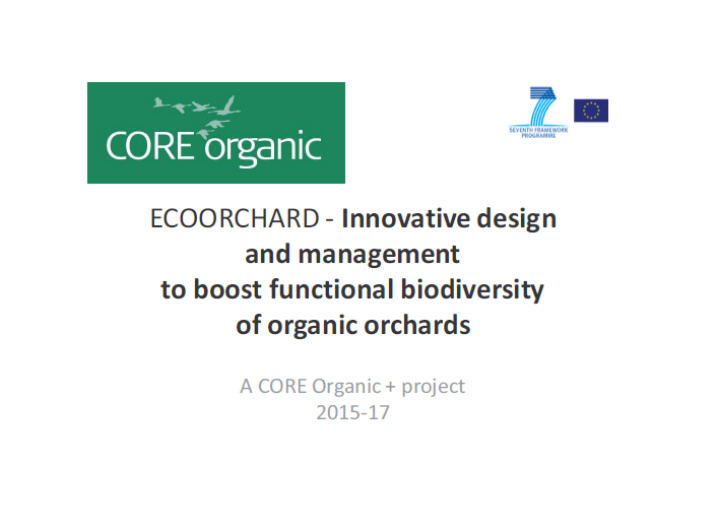



Consortium • 11 partners • 9 countries
Hypotheses The resilience of organic orchards versus pests can be improved through the implementation of specific methods and tools for increasing functional biodiversity. – M ethods and tools will be applicable for commercial organic fruit growers in a wide range of economic and ecological situations. – An active network of committed stakeholders, including practitioners ,but also from science side, can be created which takes care of the dissemination and implementation
M ain objectives 1. To develop feasible tools for (re)design of organic apple orchards and to adopt specific management practices with the aim to increase orchard resilience through higher functional (agro-)biodiversity (FAB). 2. Compare effects of FAB management across Europe for shared key pests (aphids, codling moth) and their natural enemies.
Sub-objectives 1. T o identify promising techniques, tools and monitoring protocols to improve management of functional biodiversity , which enhance the performance of natural enemies, reduce pest and disease, and are adapted for farmers’ implementation. 2. T o assess promising techniques, namely specific flora introduction to provide alternative food/ prey, and specifically adapted habitat management. 3. T o create a European-wide network of stakeholders for functional biodiversity management in organic orchards. 4. T o learn from a participatory approach about potential constraints solve these constraints by iterative re-evaluation.
Schematic representation of the project Diagram: Servane Penvern
WP1 - Tracking innovative functional biodiversity practices and systems (JKI, Annette Herz / co-leader: INRA, Servane Penvern) Objectives: • To collect knowledge on FAB management and related practices experimented or already implemented in European fruit growing • To analyze their pro and cons in terms of adoption, implementation, efficacy towards functional biodiversity and impacts on farm performances. • To select challenges, methods and innovations that could be targeted in WPs 3 & 4 in order to either solve, validate or test them in a common European-wide approach • To identify and set up a voluntary and participative platform of stakeholders (EBION: “European Biodiversity Orchards Network”) for active exchange of data during the project . Deliverable: The organic fruit sector will obtain a European-wide stakeholder platform which delivers scientifically and technically proved information on how to establish and manage more resilient orchards.
WP1 - Tracking innovative functional biodiversity practices and systems Diagram: Annette Herz and Servane Penvern
Ebion website Picture: Annette Herz
WP2 - Common methods for participatory assessment of functional biodiversity (Leader: GRAB, François Warlop / co-leader: UCPH, Lene Sigsgaard) Objectives: • To collect, test, analyze and classify different methods for assessing the impact of FAB management regarding their suitability for practice, extension and science. • To assess operational-oriented protocols with scientifically-sound methods. • To develop protocols for participatory monitoring of FAB efficiency in a wide range of apple orchards of the network. Deliverable: M anagement of existing and design of future orchards will be supported by simple protocols for monitoring of functional biodiversity elements that are suitable for wide adoption in different European countries.
WP3 – Europe-wide experimental trials of new orchard design (FiBL, Franco Weibel/ co-leader: Laurent Jamar CRA-W) Objectives: · To research BTW flower strips which are FAB elements that can be implemented rapidly and on large scale by organic fruit growers in their existing orchards. · To test the suitability of using region- and soil-specific flower mixtures , and develop methods for their practical implementation and management. · To assess the effect of BTW flower strips on the abundance and activity of natural enemies and on their effect to reduce pest pressure and pesticide applications. · To develop recommendations for growers/ advisors in WP4 on different methods to install and manage BTW flower strips. Deliverable: A novel, functional biodiversity system that can be adopted into existing orchards will be tested and validated for both, (i) its effect on pest control and pesticide reduction and (ii) on its practical feasibility across 6 European countries.
In-Between-Tractor-Wheel Flower Strips (BTW) Picture: Franco Weibel
WP3 – Europe-wide experimental trials of new orchard design • 6 partnering countries: • In at least two organically managed orchards per country • The creation of BTW- flower Strips, or/ and other biodiversity- increasing elements identified in WP1 will be tested in a scientific approach. Diagram: Franco Weibel
WP4 - Learning from all sides and dissemination (INRA, M arc Tchamitchian/ co-leader: SLU, M ario Porcel) Objectives: · To adapt monitoring methods and practices for FAB orchard management to end- users needs and constraints, with the active participation of stakeholders. · To disseminate project results within a strong, collaborative stakeholder network created in the project. · To characterize various modes of participation used in the project and analyze the learning processes between involved stakeholders. Organic growers meeting Picture: Weronika Swiergiel
Thank you for your attention! This project is funded via the ERA-net CORE Organic Plus, which is a network of 20 countries on initiating transnational research projects in the area of organic food and farming systems. In 2014, CORE Organic Plus selected EcoOrchard and 10 other projects.
Recommend
More recommend